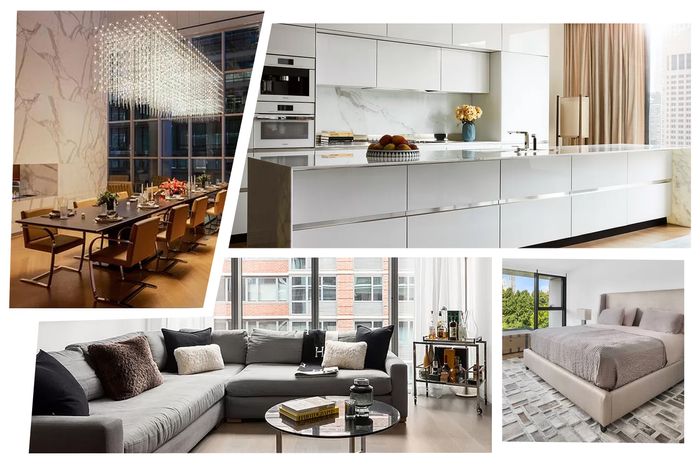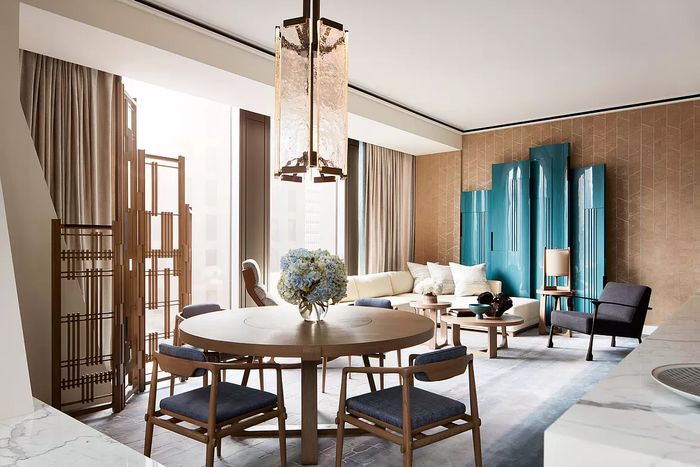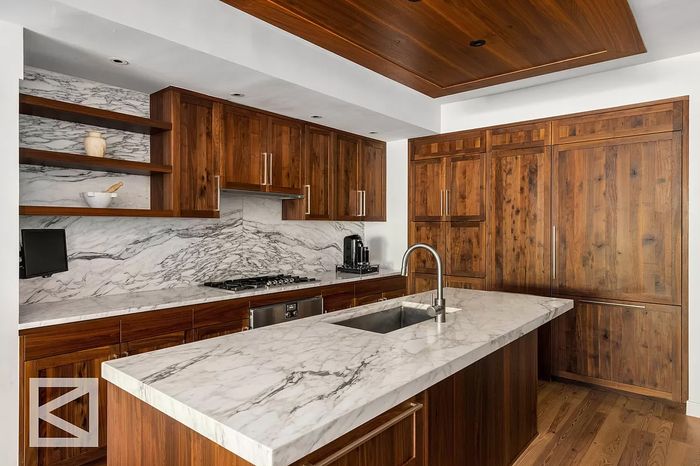
Photo-Illustration: Curbed; Photos: Douglas Elliman, Core Group Marketing
Brokers are accustomed to dealing with dated finishes — sellers are often crushed to learn that the kitchen renovation they spent $75,000 on a decade ago is now being sneered at by potential buyers — but Leonard Steinberg, a Compass broker, recently started to notice something strange: A number of new buildings were already looking, well, old.
“It used to be that seven-to-ten years was the shelf life of a beautifully finished apartment,” Steinberg says. “Now you look at something and say, ‘How can this look dated already?’” The beige, boxy accents and floating toilets in the Jean Nouvel building at 53 West 53rd, completed in 2019, are already on the outs with potential buyers, brokers say, who have moved on to the kind of sleek, spalike quartzite bathrooms you can find at One Highline. Or the standalone sculptural bathtubs at 200 East 59th, completed in 2018. “This is typical Harry Macklowe,” says one broker of the project’s original developer, known for meddling in projects’ design. “He puts a tub in front of a window and thinks it’s great.” Central Park Tower, built in 2020, has similar issues, with dark, masculine kitchens and baths, though one broker added that most things Gary Barnett has done look dated on arrival.
An apartment at the Jean Nouvel–designed 53 W. 53rd, whose finishes several brokers called out as looking tired.
Photo: Douglas Elliman
Some of it is the natural lag of renovation: The finishes were designed a year or two before construction could begin, then that took years. (Often several more than expected, as many pandemic renovators have learned.) But taste cycles have also just sped up, and so have the production turnarounds of the retailers copying high-end trends. “It’s become like fast fashion,” says Steinberg. It once took years for cheaper dupes to trickle down to West Elm or Target. Now, you can find a $64 copy of that $11,000 David Weeks light fixture on Temu. “Remember the navy kitchen with gold hardware period?” he asks. “There was so much of it, and I was like, Oh there’s too much of it. And then they came up with a really cheap version of it at Home Depot and now everyone has it. It’s like buying a Chanel jacket and then seeing it pop up at H&M. It’s painful.” (A colleague who had recently looked at an apartment with such a kitchen described it as feeling “very 2020.”)
While trend cycles have been accelerating for some time — it’s been a long trajectory from the preservation-minded This Old House to HGTV gut renos that transform everything into an open-concept modern farmhouse — things started moving a lot faster during the pandemic, which transformed many people’s relationships to their homes and social habits. How your home looked mattered that much more when you were spending so much more of your time there, staring at your succulents and mid-century knockoffs. And now these often algorithmically derived cycles can leave a interior-design enthusiast going from delight to exhaustion about, say, black stainless-steel appliances or pampas grass in a matter of weeks. Even something as banal as “bookshelf wealth” can start to feel tiresome after excessive exposure.
One of the original kitchens at Pierhouse, a Toll Brothers project that brokers say dated quickly.
Photo: Douglas Elliman
“The accessibility of design through TV shows and social media has created a lot more self-declared experts. And there is an expectation that high design is fast,” Damian Samora, a partner at Ferguson & Shamamian Architects, a firm known for classic, old-money-style renovations in places like Park Avenue, Palm Beach, and Greenwich (about as close to timeless decor as you can get), says of current market attitudes. These types of renovations take time, however — typically four years from design to construction, Samora says, “but people don’t necessarily have the appetite for four years anymore.”
“There was a long period of time when there was this specific look people were after — white, with inset Shaker cabinets, an island, soapstone or marble countertop, stainless-steel appliances. Everyone wanted it,” says Mary Mendez, director of acquisitions at Renovation Angel, a charity that refurbishes and resells high-end kitchens, who has since left the company. This meant the resale stream was fairly consistent. “We would get traditional kitchens and refinish them, and people could have a kitchen that looked new and save $50,000.”
But now, Mendez says, the model is wobbling. The “in” kitchen is white, minimalist, and German — think Poggenpohl — an impossible design to fashion out of an older, traditional kitchen, Mendez says. In a few years, she expects that they’ll get some second-hand ones in, though by then, tastes will have likely moved on. “The attention span for style and color is far shorter than it was even two years ago,” she says. (All of this is, of course, terrible for the environment.)
Patrick W. Ciccone, a preservationist and architectural historian who co-authored the updated 2019 bible of brownstone renovation, Bricks and Brownstone (the 1980 edition was even subtitled A Guide to Architectural Styles and Interior Decoration for Period Restoration), says he thinks it all started with kitchens. While in the past they were functional spaces located in the basement or back of the house, they’re now the star attraction, with all the frippery and fickleness you’d expect. “I think 50 years ago, if you were redoing a house, you’d update the kitchen, but it wasn’t a showpiece. There wasn’t the kind of conspicuous consumption there is today.”
“If you think about most spaces in a house, they don’t change that much over the years,” he says. You might swap out light fixtures or paint, but the kitchen “is the most malleable space, and it’s the one that goes out of date the fastest.” For that reason, he didn’t even want to include any kitchens in the new edition of the book but was pressed to by the publisher. People love to gawp at them.
The ones that miss the mark, and the trend, are as memorable, if not more, than the envy-inducing ones. A cautionary tale several brokers brought up was Pierhouse, at Brooklyn Bridge Park, a development from 2015 that featured reclaimed floors, exposed beams, and dark-wood kitchens with dropped ceilings. As it happened, Ellen Hamilton, of Hamilton Design Associates, knew the building well. “They worked with a good architect — Marvel — but it was a Toll Brothers interpretation of Brooklyn Hipster,” she says. “I had three clients down there.” They all ripped it out.



:max_bytes(150000):strip_icc()/everything-you-need-to-know-kitchen-islands-lead-getty-0423-3879114cb97d49e68735dcc532884ebc.jpg)
